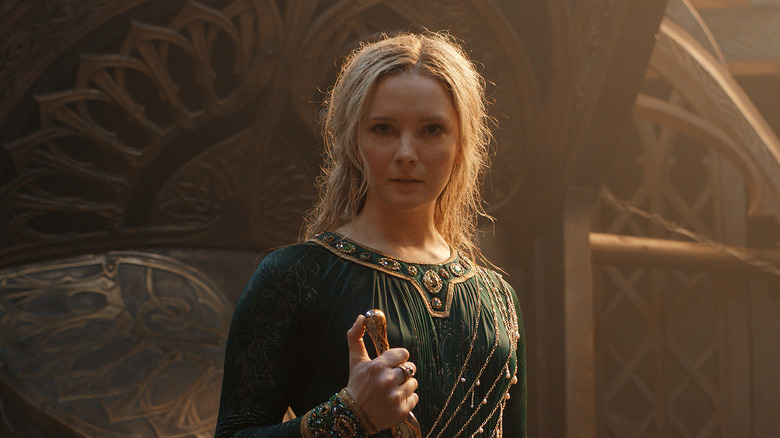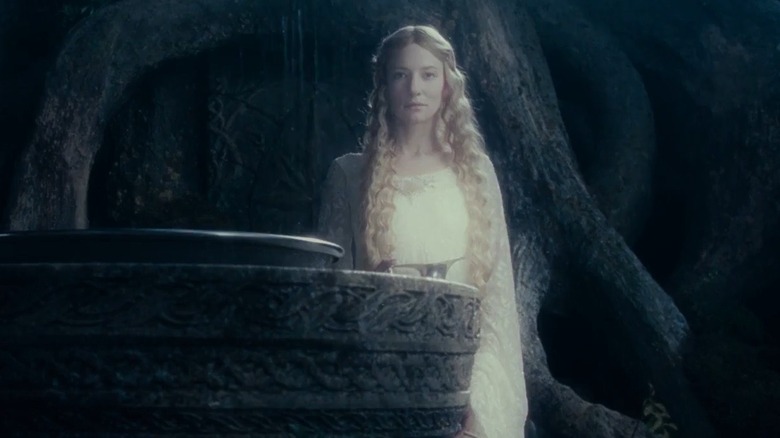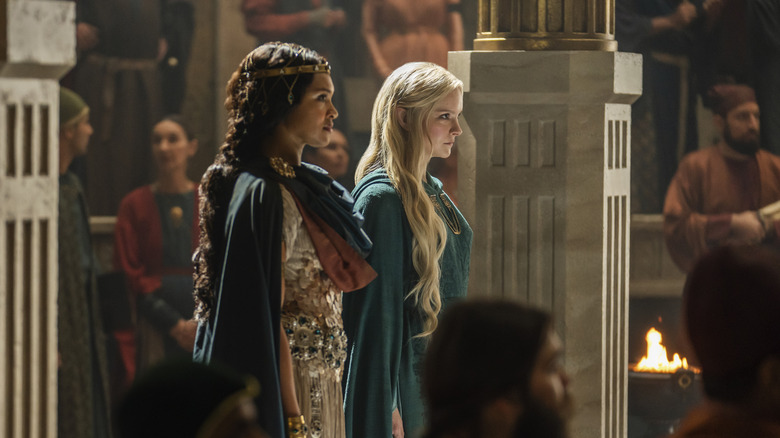Lord Of The Rings: Galadriel's Many Names & Their Meanings Explained
Galadriel is a major character in J.R.R. Tolkien's world of Middle-earth. She started by playing a fairly quiet support role in "The Fellowship of the Ring." However, the author ensured that she was busy doing plenty of important stuff behind the scenes throughout the rest of the narrative.
As he fleshed out the Galadriel character over time, Tolkien added to her backstory, slowly turning the Mistress of Magic in the Golden Wood into a She-Elf with a lengthy track record as a Middle-earth heroine and a geo-political figure that stretches back thousands of years. Some of this has been adapted in Amazon Studios' "The Rings of Power" series, which takes place in the Second Age, several thousand years before Frodo ever gets the ring. Even at that point, though, Galadriel is already quite old.
During all of this time, she earns more than just a reputation as a powerful and beautiful Elven leader. She is also given names — a lot of names. From titles to nicknames, there are over a dozen monickers used to refer to the She-Elf throughout Tolkien's writings and their related adaptations. Let's break down what these mean and where they come from, starting with the most obvious one of all: Galadriel.
What does the name Galadriel mean?
Tolkien's overpowered Elf princess is most commonly referred to as Galadriel. While the author made this name up (and explained as much in his letters to fans), its creation for the purpose of "The Lord of the Rings" and its related stories doesn't mean Galadriel has no meaning. As is so often the case with Middle-earth material, the name Galadriel is built on invented linguistic components that Tolkien translated a few different ways over the years.
In "The Silmarillion," he defines Galadriel as "maiden crowned with a radiant garland." In a letter written late in life (1973), he alters this slightly to read "Maiden crowned with gleaming hair." A year earlier, he wrote another letter in which he summarized this definition to succinctly read, "glittering garland." The best one of all comes in the book "The Peoples of Middle-earth," where Galadriel is dramatically translated as "maiden crowned with a festival garland."
Of course, all of these translations reference Galadriel's famous hair. "The Silmarillion" compares this to Laurelin, one of the Two Trees depicted in the opening sequence of "The Rings of Power." The book says, "Her hair was lit with gold as though it had caught in a mesh the radiance of Laurelin." "The Peoples of Middle-earth" adds that "her hair was held a marvel unmatched." This led to her hair becoming Galadriel's defining physical characteristic. (No wonder Gimli valued a single strand of it.) The name Galadriel may come from her hair's golden beauty, but it is by no means the only name Galadriel garners over her lifetime.
Galadriel's many other names
Tolkien gives us several other names for Galadriel. "The Peoples of Middle-earth" book states that Galadriel's official name is Nerwendë Artanis. The book "Unfinished Tales" further explains that at birth, Elves are given two different names, one immediately from their father and one soon afterward from their mother. In Galadriel's case, Artanis is from her father, Finarfin, and it means "noble woman."
Her mother's name for her, which is shortened to Nerwen in some places, means "man-maiden." For the eye-rollers out there, Nerwen is actually a body-positive title referencing Galadriel's incredible physical presence and capabilities. "The Peoples of Middle-earth" details, "She grew to be tall beyond the measure even of the women of the Noldor; she was strong of body, mind, and will, a match for both the loremasters and the athletes of the Eldar in the days of their youth."
Along with man-maiden and noble woman, Galadriel's then-lover and future husband, Celeborn, nicknames her Alatariel. More officially, it's an "epessë" — that is, an after-name often given to Elves in Middle-earth along with their mother and father-given eponyms. The name is in the form of Elvish called Telerin. (Yes, Tolkien has different versions of Elvish.) When it is translated into the more commonly spoken version of Elvish called Sindarin, it comes out as — you guessed it — Galadriel.
As a fun final note, Tolkien complicates things further by explaining in "Unfinished Tales" that once Galadriel became associated with trees, her name outside of her realm is sometimes misspelled "Galadhriel." Why? Because the element "galadh" is Sindarin Elvish for "tree."
Galadriel's many titles in Lothlórien
Along with the names, Galadriel has many titles. The simplest of these titles is "The Lady." When Tolkien references Galadriel, he uses this often. In "The Two Towers," for instance, when Sam reminds Frodo of the light-infused Phial of Galadriel, he tells him, "Master, master! The Lady's gift!" Faramir also refers to her by the almost as simple name "the White Lady."
In "The Fellowship of the Ring," Aragorn refers to her as "Lady of Lórien." too. And it's her connection with that sacred wood (which she only comes to rule later in her life) from which many of her other appellations spring. When the Fellowship of the Ring reaches Lothlórien in the book, the text variously refers to her as Galadriel the Lady of Lórien, the Lady Galadriel, and once again, The Lady. When they leave, Gimli says, "It is enough for me to have seen the Lady of the Galadhrim," referring to the people that she leads in the Golden Wood.
Interestingly, while Galadriel is born a princess, she doesn't rule Lothlórien as a Queen. On the contrary, only when Frodo offers her the One Ring does she describe a terrifying scenario in which she rules thusly, wielding royal power. In Amazon Studios' "The Rings of Power" adaptation, a similar image of "Queen Galadriel" (created for the show) was teased by Sauron when he tempted her to join him. Whenever Galadriel is shown as a Queen, though, it is a negative hypothetical scenario. Otherwise, she simply goes by "The Lady" or similar, arboreally-infused epithets.
Galadriel's negative and confusing reputation among Men
Galadriel isn't popular with mortals, and she gets multiple less-than-desirable names from them, too. When Éomer first hears of Galadriel in "The Two Towers," he says, "Then there is a Lady in the Golden Wood, as old tales tell!" Shortly after this, he tightens up the wording to the formal title Lady of the Wood. This may sound respectful out of context, but at that part of the story, the Rohirric leader is actually accusing Aragorn, Gimli, and Legolas of being sorcerers and net-weavers.
When the three travelers come to the Golden Hall, Wormtongue takes this even further, saying, "Then it is true, as Éomer reported, that you are in league with the Sorceress of the Golden Wood?" He concludes with the foreboding line, "It is not to be wondered at: webs of deceit were ever woven in Dwimordene." That last word refers to the forest of Lothlórien, and the entire statement clearly shows the dark and mistrusting reputation that Elves — and especially Galadriel — have among men.
In the same book, Faramir also talks of the sad disconnect between Elves and Men. He specifically uses Galadriel's realm as an example, reiterating that the Rohirrim shun the Golden Wood and speak of it with dread. Despite his stance as a Man who respects the Elves, Faramir himself mysteriously describes Galadriel as a Mistress of Magic and the Lady that dies not.
Even in the Hobbit community, Elven magic has a nebulous reputation. When Galadriel talks to Sam about her mirror, she says that it's technically what his people call Elf-magic, clarifying, "They seem to use the same word of the deceits of the Enemy." Galadriel's sinister reputation creates a terrifying aura amongst mortals — and plenty of sinister names come with it.
New Names for Galadriel
Despite the elaborate list of names already in existence, modern adaptations have also carved out their own unique corner of the Galadriel names archive. In Peter Jackson's "The Fellowship of the Ring," for instance, as the Fellowship of the Ring enters Lothlórien, an intensely skeptical Gimli (John Rhys-Davies) tells his Hobbit companions, "They say that a Great Sorceress lives in these woods. An Elf Witch of terrible power. All that look upon her fall under her spell and are never seen again."
Galadriel also clearly plays a big role in Amazon Studios' "The Rings of Power" series. In that show, she has already received multiple new titles in Season 1 alone. Showrunners JD Payne and Patrick McKay have had to beef up the story from Tolkien's limited source material, and part of that adaptive process manifested by making Galadriel the "Commander of the Northern Armies" of the High King Gil-galad. This new role was flaunted multiple times throughout the first season.
The best Galadriel name moment, though, came when the She-Elf (played by Morfydd Clark) arrives in the Mannish island nation of Númenor and is asked to declare herself. The proud immortal draws herself up and states that she is "Galadriel of the Noldor, Daughter of the Golden House of Finarfin, Commander of the Northern Armies of High King Gil-galad." While the Commander of the Northern Armies bit is new for the show, the rest of the impressive and exhaustive title reflects bonafide Tolkien-created Galadriel eponyms. The writers masterfully wove these together, using the occasion to show off her many names and titles and to reflect the impressive person they refer to. It's a fun moment and one that summarizes Galadriel's elaborate apellations to a "t."





